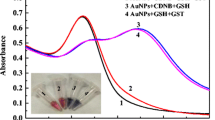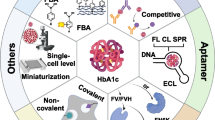Abstract
A Golgi protein 73 (GP73) colorimetric biosensor based on the reduced graphene oxide-carboxymethyl chitosan-hemin/platinum@palladium nanoparticles (RGO-CMCS-Hemin/Pt@Pd NPs) with peroxidase-like activity was constructed. The RGO-CMCS-Hemin/Pt@Pd NPs with high peroxidase-like activity were successfully synthesized under mild conditions. Then, the aminylated GP73 aptamer (Apt) was bound to the RGO-CMCS-Hemin/Pt@Pd NPs to form the recognition probe. Another unmodified GP73 aptamer (AptI) was served as the capture probe. In the presence of target GP73, the capture probe and the recognition probe specifically bind to GP73 and form a RGO-CMCS-Hemin/Pt@Pd NP-Apt/GP73/AptI sandwich-type structure, which can oxidase the colorless 3,3′,5,5′-tetramethylbenzidine (TMB) into blue oxTMB in the presence of H2O2. GP73 detection was achieved by measuring the peak UV absorption at 652 nm. Under the optimum conditions, the GP73 concentration was linearly related to the absorbance intensity in the range 10.0–110.0 ng/mL, and the limit of detection (LOD) was 4.7 ng/mL. The proposed colorimetric biosensor was successfully applied to detect GP73 in spiked human serum samples with recoveries of 98.2–107.0% and RSDs of 1.90–5.44%, demonstrating the excellent potential for highly sensitive GP73 detection in clinical detection.
Graphical abstract
A colorimetric biosensor for visual determination of GP73 based on RGO-CMCS-Hemin/Pt@Pd NPs nanozyme with peroxidase-like activity was designed. The GP73 biosensor responses linearly from 10.0–110.0 ng/mL with LOD of 4.7 ng/mL, and shows acceptable specificity and good recovery.






Similar content being viewed by others
References
Bray F, Ferlay J, Soerjomataram I, Siegel RL, Torre LA, Jemal A (2018) Global cancer statistics 2018: Globocan estimates of incidence and mortality worldwide for 36 cancers in 185 countries. CA: a Cancer J Clin 68:394–424. https://doi.org/10.3322/caac.21492
Kimhofer T, Fye H, Taylor-Robinson S, Thursz M, Holmes E (2015) Proteomic and metabonomic biomarkers for hepatocellular carcinoma: a comprehensive review. Brit J Cancer 112:1141–1156. https://doi.org/10.1038/bjc.2015.38
Wang L, Yao M, Liu S, Yang D, Wen X, Ning J, Wang L, Zhou G, Xu Q, Chen X, Zhao J, Lu F (2020) Serum golgi protein 73 as a potential biomarker for hepatic necroinflammation in population with nonalcoholic steatohepatitis. Dis Markers 2020:6036904. https://doi.org/10.1155/2020/6036904
Marrero JA, Romano PR, Nikolaeva O, Steel L, Mehta A, Fimmel CJ, Comunale MA, D’Amelio A, Lok AS, Block TM (2005) GP73, a resident Golgi glycoprotein, is a novel serum marker for hepatocellular carcinoma. J Hepatol 43:1007–1012. https://doi.org/10.1016/j.jhep.2005.05.028
Lin Y, Jia J, Yang R, Chen D, Wang J, Luo F, Guo L, Qiu B, Lin Z (2019) Ratiometric immunosensor for GP73 detection based on the ratios of electrochemiluminescence and electrochemical signal using DNA tetrahedral nanostructure as the carrier of stable reference signal. Anal Chem 91:3717–3724. https://doi.org/10.1021/acs.analchem.9b00013
Yang Z, Qian J, Yang X, Jiang D, Du X, Wang K, Mao H, Wang K (2015) A facile label-free colorimetric aptasensor for acetamiprid based on the peroxidase-like activity of hemin-functionalized reduced graphene oxide. Biosens Bioelectron 65:39–46. https://doi.org/10.1016/j.bios.2014.10.004
Shaban SM, Kim DH (2021) Recent advances in aptamer sensors. Sensors (Basel, Switzerland) 21. https://doi.org/10.3390/s21030979
Ruirui Z, Yunfeng B, Xiaoliang C, Feng F, Shaomin. Shuang, (2020) Advances in the study of aptamers in cancer diagnosis and targeted therapy. Chem Bulletin 83:977–985. https://doi.org/10.14159/j.cnki.0441-3776.2020.11.003
Yuanbin G, Kun L (2021) Advances in the study of nucleic acid aptamers in cancer diagnosis. Chem Bulletin 84:40–46. https://doi.org/10.14159/j.cnki.0441-3776.2021.01.006
Du J, Hong J, Xu C, Cai Y, Xiang B, Zhou C, Xu X (2015) Screening and identification of ssDNA aptamer for human GP73. Biomed Res Int 2015:610281. https://doi.org/10.1155/2015/610281
Xiao S, Lu J, Sun L, An S (2022) A simple and sensitive AuNPs-based colorimetric aptasensor for specific detection of azlocillin. Spectrochim Acta A 271:120924. https://doi.org/10.1016/j.saa.2022.120924
Chen M, Zhong L, Feng H, Li G (2021) Golgi protein 73 colorimetric biosensor based on reduced graphene oxide-trimanganese tetroxide nanozyme. J Phys Conf Ser 2021.https://doi.org/10.1088/1742-6596/2021/1/012065
Watanabe T, Hiraoka Y, Suda K, Kawamoto T, Yano H, Inukai J, Hirosawa I (2019) Development of combined small-angle X-ray scattering and fluorescence yield X-ray absorption spectroscopy measurement systems for characterization of structural and chemical information of Pt alloy nanoparticle catalyst. ECS MA 2019–02:1593–1593. https://doi.org/10.1149/ma2019-02/35/1593
DeRita L, Resasco J, Dai S, Boubnov A, Thang HV, Hoffman AS, Ro I, Graham GW, Bare SR, Pacchioni G, Pan X, Christopher P (2019) Structural evolution of atomically dispersed Pt catalysts dictates reactivity. Nat Mater 18:746–751. https://doi.org/10.1038/s41563-019-0349-9
Qu Y, Zheng Z, Yu Z, Song M, Zhang Y, Zhao Y, Yu J (2021) Chain-like PtPd nanoparticles with a long-time stability as an efficient electrocatalyst for alcohols oxidation reaction. Colloid Surface A 631:127756. https://doi.org/10.1016/j.colsurfa.2021.127756
Ji X, Han Z, Li J, Deng Y, Han X, Zhao J, Zhao X, Chen C (2019) MoSx co-catalytic activation of H(2)O(2) by heterogeneous hemin catalyst under visible light irradiation. J Colloid Interf sci 557:301–310. https://doi.org/10.1016/j.jcis.2019.09.027
Kolupaev YE, Shkliarevskyi MA, Karpets YV, Shvidenko NV, Lugovaya AA (2021) ROS-dependent induction of antioxidant system and heat resistance of wheat seedlings by hemin. Russ J Plant Physl 68:322–330. https://doi.org/10.1134/S102144372101009X
Lei L, Tu Q, Jiao L, Xiang S, Wang L, Ran X, Xiao B, Feng G, Feng J, Zhang C (2022) Reactive oxygen species scavenging by hemin-based nanosheets reduces Parkinson’s disease symptoms in an animal model. Chem Eng J 432.https://doi.org/10.1016/j.cej.2021.134356
Zhang G, Liu Z, Fan L, Guo Y (2018) Electrochemical prostate specific antigen aptasensor based on hemin functionalized graphene-conjugated palladium nanocomposites. Microchim Acta 185:159. https://doi.org/10.1007/s00604-018-2686-9
Li J, Zhuang S (2020) Antibacterial activity of chitosan and its derivatives and their interaction mechanism with bacteria: current state and perspectives. Eur Polym J 138.https://doi.org/10.1016/j.eurpolymj.2020.109984
Li J, Wang B, Gu S, Yang Y, Wang Z, Xiang Y (2017) Amperometric low potential aptasensor for the fucosylated Golgi protein 73, a marker for hepatocellular carcinoma. Microchim Acta 184:3131–3136. https://doi.org/10.1007/s00604-017-2334-9
Li G, Feng H, Shi X, Chen M, Liang J, Zhou Z (2021) Highly sensitive electrochemical aptasensor for glypican-3 based on reduced graphene oxide-hemin nanocomposites modified on screen-printed electrode surface. Bioelectrochemistry 138:107696. https://doi.org/10.1016/j.bioelechem.2020.107696
Wang L, Zhou H, Wu X, Song Y, Huang Y, Yang X, Chen X (2022) A novel colorimetric aptasensor for sensitive tetracycline detection based on the peroxidase-like activity of Fe3O4@Cu nanoparticles and “sandwich” oligonucleotide hybridization. Microchim Acta 189. https://doi.org/10.1007/s00604-022-05195-8
Han X, Russo PA, Triolo C, Santangelo S, Goubard-Bretesché N, Pinna N (2020) Comparing the performance of Nb2O5 composites with reduced graphene oxide and amorphous carbon in Li- and Na-Ion electrochemical storage devices. ChemElectroChem 7:1689–1698. https://doi.org/10.1002/celc.202000181
Hui W, Tao P, Zongkui K, Jian Z, Kun C, Daping H, Mu P, Shichun M (2015) Core-shell graphene@amorphous carbon composites supported platinum catalysts for oxygen reduction reaction. Chinese J Catal 36:490–495. https://doi.org/10.1016/S1872-2067(14)60211-4
Song Y, Liu W, Mu X, Zhong X, Cui A, Sun Y, Crockett JR, Bao Y, Shan G, Chen Y (2021) Photothermal-enhanced peroxidase-like activity of CDs/PBNPs for the detection of Fe(3+) and cholesterol in serum samples. Microchim acta 189:30. https://doi.org/10.1007/s00604-021-05129-w
Mu Z, Wu S, Guo J, Zhao M, Wang Y (2022) Dual mechanism enhanced peroxidase-like activity of iron–nickel bimetal–organic framework nanozyme and its application for biosensing. ACS Sustain Chem Eng 10:2984–2993. https://doi.org/10.1021/acssuschemeng.1c07975
Zhou C, Chen J, Wang G, Su X (2022) Heparin-enhanced peroxidase-like activity of iron-cobalt oxide nanosheets for sensitive colorimetric detection of trypsin. Microchim Acta 189:135. https://doi.org/10.1007/s00604-022-05227-3
Wang X, Ouyang F, Cui L, Xiong T, Guan X, Guo Y, Duan S (2019) Surface coating–modulated peroxidase-like activity of maghemite nanoparticles for a chromogenic analysis of cholesterol. J Nanopart Res 21.https://doi.org/10.1007/s11051-019-4662-7
Wang C, Gao J, Tan H (2018) Integrated antibody with catalytic metal-organic framework for colorimetric immunoassay. ACS Appl Mater Interfaces 10:25113–25120. https://doi.org/10.1021/acsami.8b07225
Liu W, Zhang A, Xu G, Wei F, Yang J, Hu Q (2016) Manganese modified CdTe/CdS quantum dots as an immunoassay biosensor for the detection of Golgi protein-73. J Pharmaceut Biomed 117.https://doi.org/10.1016/j.jpba.2015.08.020
Jing J, Ye W, Jiang Y, Ma J, Zhu M, Ma J, Zhou H, Yu L, Yang Y, Wang SC (2017) The value of GPC3 and GP73 in clinical diagnosis of hepatocellular carcinoma. Clin Lab 63:1903–1909. https://doi.org/10.7754/Clin.Lab.2017.170712
Xia Y, Yao H, Xu P, Xu C, Sun L, Zhu F, Li Y (2017) Comparison of two latex nanoparticles with different diameters and the application in detection of biomarker Golgi protein 73 in hepatocellular carcinoma. Nanosci Nanotech Let 9:398–405. https://doi.org/10.1166/nnl.2017.2354
Zhang Y, Huang X, Luo F, Lei Y, Chen L, Weng Z, Guo L, Lin Z (2018) Highly sensitive electrochemical immunosensor for Golgi protein 73 based on proximity ligation assay and enzyme-powered recycling amplification. Anal Chim Acta 1040:150–157. https://doi.org/10.1016/j.aca.2018.08.021
Wu Y, Ma J, Wang Y, Zhang Y, Hou Y, Zhang C, Sun H, Sun J, Wang Z, Li N (2018) Development of an alpha-fetoprotein and Golgi protein 73 multiplex detection assay using xMAP technology. Clin Chim Acta 482:209–214. https://doi.org/10.1016/j.cca.2018.03.039
Aixia Z, Brian C (2012) Generation and characterization of an anti-GP73 monoclonal antibody for immunoblotting and sandwich ELISA. J Biom Res 26.https://doi.org/10.7555/JBR.26.20120057
Funding
This work was supported by the National Nature Science Foundation of China (No. 62161009), Projects of Talents Recruitment of GDUPT (XJ2022000401), the Open Fund of Guangxi Key Laboratory of Information Materials (No. 211022-K), and the Fund of Guangxi Key laboratory of Metabolic Diseases Research (No. 20–065-76).
Author information
Authors and Affiliations
Contributions
Xinhao LI: Methodology, data curation, writing—original draft preparation. Shengnan LI: Software; writing, original draft preparation; validation. Qiuyan Lv: Methodology, conceptualization. Chaoxian WANG: Visualization, software, data curation. Jintao Liang: Data curation, writing—reviewing and editing. Zhide ZHOU: Supervision, writing—reviewing and editing. Guiyin LI: Supervision, writing—reviewing and editing.
Corresponding authors
Ethics declarations
Ethics approval
The human serum samples used in this study were approved by the Guangxi Key Laboratory of Metabolic Diseases Research Ethics Committee in Guilin, China.
Conflict of interest
The authors declare no competing interests.
Additional information
Publisher's note
Springer Nature remains neutral with regard to jurisdictional claims in published maps and institutional affiliations.
Highlights
• The RGO-CMCS-Hemin/Pt@Pd NPs with admirable peroxidase-like activity were synthesized.
• GP73 colorimetric sensor based on RGO-CMCS-Hemin/Pt@Pd NPs and aptamer was constructed.
• GP73 detection is achieved by measuring the absorbance changes for TMB-H2O2 system.
• GP73 biosensor responses linearly from 10.0 to 110.0 ng/mL with LOD of 4.7 ng/mL.
• GP73 colorimetric biosensor shows acceptable specificity and good recovery.
Supplementary Information
Below is the link to the electronic supplementary material.
Rights and permissions
Springer Nature or its licensor holds exclusive rights to this article under a publishing agreement with the author(s) or other rightsholder(s); author self-archiving of the accepted manuscript version of this article is solely governed by the terms of such publishing agreement and applicable law.
About this article
Cite this article
Li, X., Li, S., Lv, Q. et al. Colorimetric biosensor for visual determination of Golgi protein 73 based on reduced graphene oxide-carboxymethyl chitosan-Hemin/platinum@palladium nanozyme with peroxidase-like activity. Microchim Acta 189, 392 (2022). https://doi.org/10.1007/s00604-022-05480-6
Received:
Accepted:
Published:
DOI: https://doi.org/10.1007/s00604-022-05480-6




